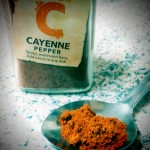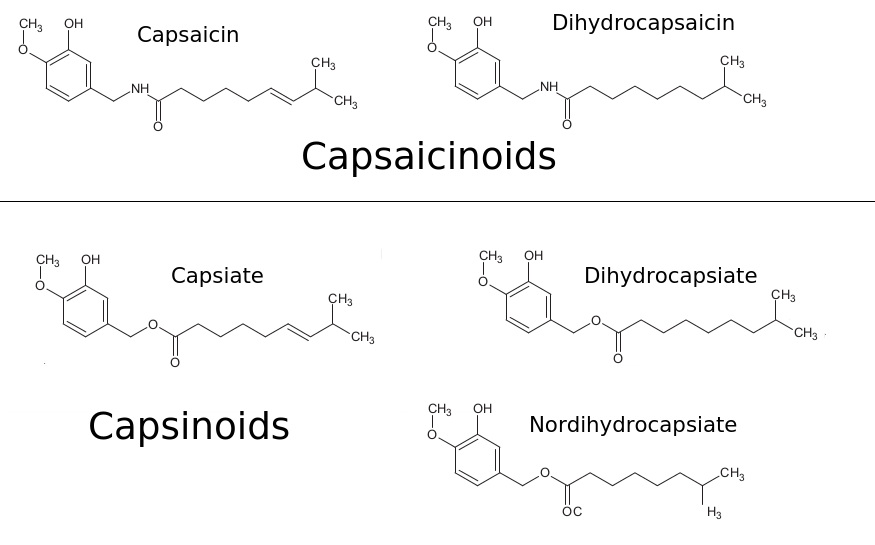 Capsaicinoids and capsinoids are a number of closely related compounds found in chilli peppers (figure 1)1. Capsaicinoids are thought to be produced as a defence mechanisms against predators as they give chillies their pungent taste. The main capsaicinoids in chilli peppers are capsaicin and dihydrocapsaicin, which account for 50% of the capsaicinoids. A group of structurally related compounds in chillies, the capsinoids, have also been recently discovered. The capsinoids capsiate, dihydrocapsiate and nordihydrocapsiate lack the pungency of the capsaicinoids, and hence the pepper they were first extracted from is called sweet-19. Capsaicinoids and capsinoids are of interest nutritionally because they show thermogenic properties. Therefore extracts of chilli peppers may be useful adjuncts to weight loss. All the capsaicinoids appear to show some thermogenic properties, but the capsinoids are of particular interest because while being thermogenic they lack the ferocious taste of the capsaicinoids.
Capsaicinoids and capsinoids are a number of closely related compounds found in chilli peppers (figure 1)1. Capsaicinoids are thought to be produced as a defence mechanisms against predators as they give chillies their pungent taste. The main capsaicinoids in chilli peppers are capsaicin and dihydrocapsaicin, which account for 50% of the capsaicinoids. A group of structurally related compounds in chillies, the capsinoids, have also been recently discovered. The capsinoids capsiate, dihydrocapsiate and nordihydrocapsiate lack the pungency of the capsaicinoids, and hence the pepper they were first extracted from is called sweet-19. Capsaicinoids and capsinoids are of interest nutritionally because they show thermogenic properties. Therefore extracts of chilli peppers may be useful adjuncts to weight loss. All the capsaicinoids appear to show some thermogenic properties, but the capsinoids are of particular interest because while being thermogenic they lack the ferocious taste of the capsaicinoids.
Figure 1. The structures of the capsaicinoids and capsinoids.
Capsaicinoids and capsinoids have been investigated with respect their fat loss effects and found to be effective for long term weight loss. In this regard they are thought to have three main modes of action. Capsaicinoids and capsinoids can increase thermogenesis and fat oxidation. In combination this can increase total energy expenditure by around 50 kcal per day which can contribute to significant weight loss over a number of years1. A significant loss of abdominal fat, the type associated with metabolic syndrome, has been reported in studies investigating capsinoid supplements. This effect may be particularly beneficial because central adiposity is a risk factor for cardiovascular disease. In addition to these thermogenic properties, the capsaicinoids may also increase satiety. Following ingestion of capsaicin containing foods, ad libitum energy intakes decrease and ratings of hunger are reduced. Therefore there is good evidence that the capsaicinoids and capsinoids have potentially beneficial effects at weight loss in humans.
The thermogenic properties of capsaicinoids and capsinoids are thought to occur through stimulation of the TRPV1 (transient receptor potential vanilloid type-1) receptor, a cation channel involved in the regulation of body temperature. Activation of the receptor causes a release of catecholamines that then stimulates the central nervous system via beta receptors. The ability of the capsinoids to produce the thermogenic properties of capsaicinoids but without the pungency, relates to their inability to stimulate receptors in the mouth, due to structural differences. However, the appetite reducing effects of chilli peppers may be sensory in origin and relate to the ability of the capsaicinoids to stimulate oral receptors. Therefore the capsinoids may not be as effective as the capsinoids at reducing hunger and increasing satiety. Most weight loss studies to date have involved the use of supplements. However, liberal use of chillies and powder in food would likely have similar effects, although the capsinoid content of regular chillies is low.

